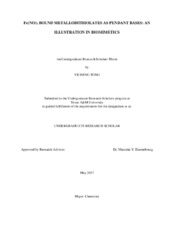| dc.description.abstract | Literature Review
Clean energies, as solar and wind power, have been used to produce electric energy, but the storage of electric power in batteries is not sufficient, and the production of batteries also generates waste. Keeping these energies in chemical bonds, the H-H bonds, would give a more sufficient way since the later use of this chemical bond energy will only generate water releasing to the atmosphere. But the efficiency of utilizing the electricity energy for hydrogen production is still ineffective. An efficient catalyst is needed to increase the efficiency and lower the cost for dihydrogen production. The [FeFe]-hydrogenase, discovered by Stephenson and Stickland in 1931 were found to be produce hydrogen in nature. [1]
The hydrogenase is an enzyme that the active sites locate on the protein molecule. The active site of [FeFe]-hydrogenase enzyme with a pendant amine base inspires a profound interest in synthesizing such heterobimetallic model complexes for dihydrogen production. [2], [3] Previous studies of [MN2S2•Fe(CO)(η5-C5H5)]+ complexes indicated the hemi-lability of metallodiothiolates and their proficiency to act as a pendant base facilitating electrocatalysis for hydrogen production. [4]
1
Thesis Statement
This research focus on the synthesis of a similar structure, [M(N2S2) •Fe(Imes)(NO)2]+, (M = Ni, Co(NO)) and the illustration of the free thiolate of this complex which could act like a pendant base.
Theoretical Framework
The basicity of the free thiolate of the heterobimetallic complex can be illustrated by binding with proton. Since proton is not detectable by X-ray diffraction, Au+ complexes are used to show that the free thiolates of [M(N2S2) •Fe(Imes)(NO)2]+ (M = Ni, Co(NO)) complexes act as a pendent base for substitute since its similar electron configuration arrangement. Thus, Au+ complexes are surrogates of protons to mimic the protonation process for the illustration.
Project Description
Our present research pursues binding of metallodithiolates (M = Ni2+, Fe(NO)2+, Co(NO)2+) to a carbene (Imes) stabilized {Fe(NO)2}9 core that result in a thiolate bridged (μ-S) monomeric or dimeric formulation. The addition of Au+ complexes into the bimetallic complexes results in a mimic of protonation to the free thiolate. The following isolation of Au+ bound trimetallic intermediate that will indirectly verify the concept of thiolates as pendant bases. Synthetically, addition of an acetonitrile adduct of [AuPPh3]+ to [M(N2S2) •Fe(Imes)(NO)2]+ (M = Ni2+, Fe(NO)2+, Co(NO)2+) at -40 oC, under anaerobic conditions, will be used to trap the [M(N2S2)•Fe(AuPPh3)(Imes)(NO)2]2+ trimatallic intermediate. The synthesized [M(N2S2) •Fe(Imes)(NO)2]+ (M = Ni2+, Fe(NO)2+, Co(NO)2+) complexes will be characterized by X-ray diffraction and in the solution state by infrared (IR), electron paramagnetic resonance (EPR), and nuclear magnetic resonance (NMR) spectroscopy. | en |


